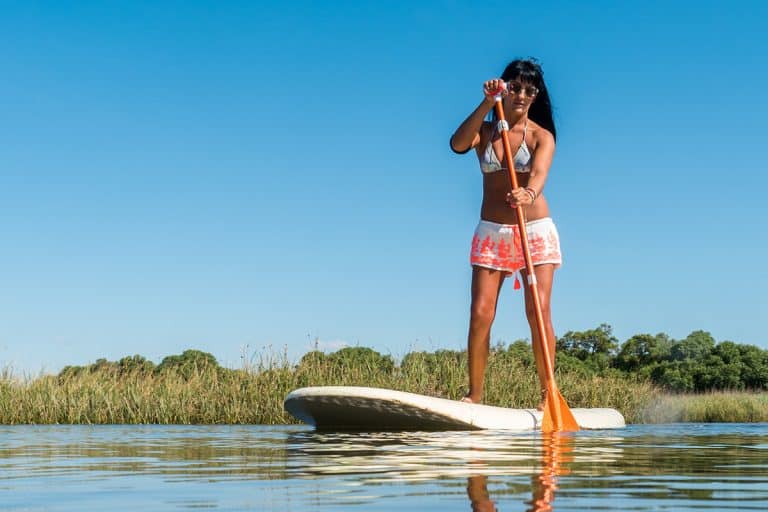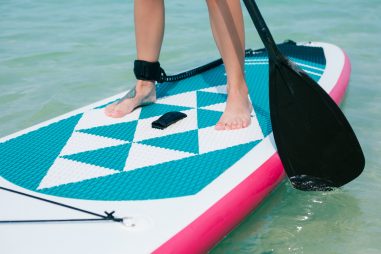The laid-backness of the paddling attracts people of all gender and ages to try it out. Paddling in flat-water and calm rivers are the most popular locations to practice and try SUP. This sport can now be even combined with yoga exercises and fishing. You may not be perfectly fit to start SUP but to further enjoy standup paddling a good sense of balance and core strength is necessary.
Is It Easy to SUP?
A stand-up paddle is considered one of the easiest sports to learn. Unlike other water sports that need a lot of lessons from their trainer, beginner paddlers can stand, balance, and do strokes without investing so much time. Having the right gears, location, and good water behavior makes SUP more bearable for beginners.
It is advisable to have an experienced paddler to equip you with the right size of paddle board for your weight and an exact paddle length for your height. For learners try to choose calm water to practice paddling. Smooth and smaller waves will help you get ready for facing more challenging waves. Maintaining proper paddling techniques and continuous practice will surely make you an expert on SUP in no time.
How Difficult Is SUP?
Learning to standup paddle is very simple and straightforward. It is known as a less grueling sport and not very physically demanding for a paddler of all ages. Like any other sports, you need a lot of practice to be more comfortable standing on your board and enjoy SUP in any water condition.
By simply practicing proper standup paddle techniques and safety practices you will more efficient and confident on your board. Although you need not be 100 percent fit to enjoy the sport, strengthening your core strength and improving your balance will greatly increase your paddling skills. Overall paddling is a sport for people of any gender and age and will be most enjoyable to do with your friends.
Is SUP Easier or Harder Than Surfing?
A paddle board is generally easier than traditional surfing. For water-based sports, surfing is considered one of the hardest sports to learn and master. While these two sports are somewhat relatable in terms of gears and execution there is still a wide difference in each activity.
You can do a lot of activities with SUP like yoga, fishing, gentle paddling in lakes, streams, and seas, waterfall paddling, whitewater paddling, and the list goes on. Even though you cannot do the same activity in surfing, catching and riding waves takes a lot of skill for a surfer. Performing different surfing execution and complex tricks are harder to learn. To sum up, both sport is changing in their own way and it is up to you to pick which is best for you.
Does SUP Help Surfing?
SUP is commonly used for fitness like practicing yoga and even fishing. This sport enhances essential skills for surfing and board water sports. SUP greatly increases your board stability, core strength, sense of balance, and stamina. Surfing is a very physical sport; it is a good idea to try SUP before transitioning to traditional surfing.
Similar to surfing you can also practice riding waves in SUP. The overall idea of popping out of the water after catching a wave is the same for both SUP and surfing. Using a paddle is a huge advantage for SUP over surfing, as you can push yourself into and out of the wave with the use of the paddle. This gets you an extra boost and speed to ride the waves and continue surfing.
How Do I Start SUP Surfing?
Standup paddle surfing is less popular in the surfing world and most traditional surfers despise the idea of using a paddle for surfing until they saw professional surfers do radical tricks with the help of the paddle. Like surfing, you need solid core strength, good balance, and board control to be able to SUP surf. Below is a short guide that can help you begin your stand up paddle surfing:
- Get the right gear: Having the proper size of board for your weight and the right length of the paddle based on your height is essential to SUP surfing. You may want to have a paddle that can dig you through the wave and a right board that will help stay footed while riding a wave.
- Going to the surf: One of the challenges for any surfers is getting inside that surfing zone and positioning yourself in the location before the wave forms. Before paddling through the wave, locate the dangerous areas like rocks and shallow beach breaks. Also, try to avoid crowded areas and swimmers.
- Catch the wave: Choosing the right wave and positioning yourself before the wave hits you is the key to start surfing. Select a wave that will give you enough time to turn your board without rushing. Before the wave hits paddle a few strokes until the wave hits you then switch to full surf stance.
- Riding the wave: Once you ride the wave you will find it easier to stay on the wave while paddling through the wave. Digging your blade will help you maneuver and balance even in mushy waves.
- Etiquette: Avoid large crowds when standup paddle surfing and remember to share the waves with fellow beachgoers. Enjoy!
As Standup paddle evolves more and more activities are being discovered to pair with this sport. Although most of the paddlers will stick on flat water and rivers, SUP surfing is indeed a great addition to the surfing world.
Do You Need SUP Lessons?
Standup paddle is so simple that you do not need to take lessons to get started. By your own instincts and a few instructions, almost all can figure out for themselves how to get on the board and start paddling. Most of the rentals offer SUP lessons for beginners but it is much enjoyable to learn by your own mistakes than hearing it from an instructor.
Try to learning SUP in smooth water and small waves if you are a beginner. This will help you be safer and more confident in learning to paddle. If you are a beginner and can only practice SUP in a fast-flowing river or in much aggressive water taking lessons to learn safety procedures from an instructor is advisable. Taking SUP lessons is entirely up to you and how you want to learn but unlike other sports, you can start standup paddle without taking hours of lessons to ride the board on the water.
Is It Safe to SUP Alone?
It is always safer to have a buddy when going to SUP. As a beginner, it is always a bad idea to go standup paddling alone. Always notify someone where you are going and for how long and far you want to go paddling. Although it is legal to go SUP alone it should only be done by professionals.
As a safety measure, you should also check out the weather for the day. Learn if it is going to rain and know the wind direction and tides to prepare yourself. You should also study the place and routes of the place where you are going before heading out. Don’t get overconfident and do things beyond your paddling ability.
How Can I Practice SUP at Home?
There are a lot of ways to improve your stand-up paddle skills at home. You may want to focus your training on a certain aspect you feel needs improvement. These are some of the SUP fitness you may want to consider focusing on:
- Core muscles
- Shoulder and arm endurance
- Cardio
- Balance and stability
While it is possible to do some SUP exercises at home without exercising equipment having a set of dumbbells, resistance bands, weighted bar, balance board, and other equipment will improve your exercise. To name a few these exercises are most common to do at home to practice SUP: Side plank with leg raise, Plank T rotations, Pushups, Balance Pushup, Paddle Squats, Lift exercise, and many more. Choose what best is applicable for you and your equipment at home and work out as much as you like to improve your next SUP experience.
How Can I Improve My SUP?
The first thing to note before going to other SUP skills is be sure to that you master the basics of paddling. You may want to develop in your system the proper SUP disciplines before exploring other paddling techniques to make sure you are on the right path in improving. If you feel you are ready you may try to do more advanced paddling techniques and getting into much rougher water or try SUP surfing.
Surf with a friend or someone who is more experienced than you. Going standup paddle with other people is common and a natural experience for a paddler. Try to learn as much as possible by observing and studying them. Don’t be afraid to get feedback from them as you try new SUP tricks. Remember to always be patient with yourself and most importantly enjoy the process!
How Can I Improve My SUP Balance?
Standing on board and not falling off the water is one of the keys to making paddling enjoyable. While most people find it easy to get on top of the board, staying standing on the paddleboard for an extended period needs a lot of stamina and a good sense of balance especially in rough waters. Your lower body strength plays a huge role in your balance in a prolonged period of hours. Here are some of the best exercises to improve your SUP balance:
- Wall Squats
- Tuck Jumps
- Weighted Step-ups
- Squat Jumps
- Lateral Squats
- Bosu Ball Exercises
How Do I Train for SUP Race?
You are a few months away from your ever first SUP race and want to be physically and mentally ready. A crucial part to successfully finish your race is to come up with a training plan. A training plan for a SUP race will help you point out the strategies, objectives and determines the measures you should do to hit your goal.
- Plan your races: To sufficiently train and develop your fitness choose an event that is around three months away if possible. These three months will allow you to prepare and get into shape to participate in the race.
- Start right: The first month will be crucial for your preparation as you need to work out your fitness by shedding some pounds, going out to jog, and get to the gym. If conceivable you may want to have a personal trainer that will guide you in your workouts.
- Stick to your training plan: You may need to sacrifice some of your social activities to get into shape. It means spending more time in the gym than hanging out with your peers to be consistent and firmly following your food diet.
- Peak Training: As you begin to pick up the pace of your training the second month will the peak time for your training. During this time, you may want to increase the weight and sets you are doing and push yourself to the limit.
- De-escalate: In the third month of training, you may feel strong and capable for the race. Taper down a little as you don’t want yourself to be too burned out by training before the race. While remaining focused on the goal develop the areas you feeling lacking and rest as needed. Ready your gears and enjoy your SUP race!








